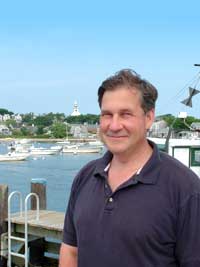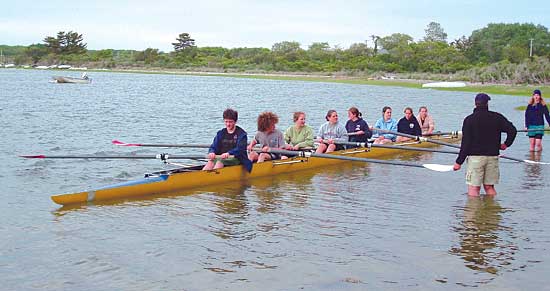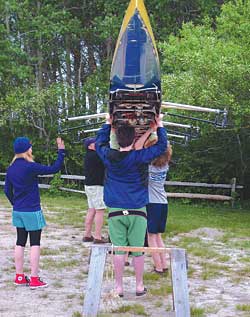Rowing Returns to Island
by Barbara Gookin
 The start of Nantucket Rowing Club has been a long time coming. An undertaking of this sort requires a community effort, as well as someone to champion the cause. Enter Rick Porteus, who came to Nantucket as a commuting teacher from the Cape two years ago. He now lives on a 47-foot boat in Nantucket Harbor year-round, and commutes home to wife Kathy on the weekends, while his children George and Emma have been away at college.
The start of Nantucket Rowing Club has been a long time coming. An undertaking of this sort requires a community effort, as well as someone to champion the cause. Enter Rick Porteus, who came to Nantucket as a commuting teacher from the Cape two years ago. He now lives on a 47-foot boat in Nantucket Harbor year-round, and commutes home to wife Kathy on the weekends, while his children George and Emma have been away at college.
Porteus spent most of his life rowing or coaching rowing. His childhood summers were spent “fiddling around” on boats at his grandparents home in Wareham. He was a track athlete competing in shot put and the 440m sprint at Tabor Academy when he joined the crew team. That's when it all came together. His love of being on the water was matched by the thrill of skimming the surface in a speeding boat.
Rick went on to receive a varsity letter in rowing at Tabor and again at Harvard. He went on to Cambridge Boat Club and competed in The Head of The Charles Regatta many times. Twenty years ago he founded Barnstable Rowing Club, with women's and youth rowing, and has since helped create crew teams at several schools on Cape Cod. He spent ten years on the committee of management of New England Interscholastic Rowing Association, and five years as chairman.
Porteus brings a lot of experience and enthusiasm to his Nantucket students—and when during an informational session in the spring of 2006, Nantucket High School students offered up their support. Their encouragement has echoed in the halls of NHS for the past year. Students have routinely approached Mr. Porteus, eagerly asking and anticipating an answer to the oft heard question; "When will the boats arrive?"

Photos by Barbara Gookin
In recent years, the sport of rowing has expanding from an elite, male dominated, competitive sport to a more relaxed, recreational form of exercise for women and men of all ages and levels. There are more than 100,000 participants in rowing clubs today. The Head of The Charles Regatta held each October in Boston is now the largest rowing event in the world. It was established and continues to be hosted by the Cambridge Boat Club.
Most students interested in rowing are not perennial athletes involved in contact sports. Students who choose to be on a crew team are selecting a true team sport without individual glory. Mostly they are kids who enjoy being on the water. Competitive rowing is extremely rigorous, but can be personally rewarding for any healthy person willing to submit themselves to the training required. In fact, rowing is considered by some enthusiasts to be the most physically gruelling of all sports: it requires substantive strength and precision, yet can appear as graceful as a ballet.
The sport is unique in that it is suitable for people of any age or gender. It’s a low-impact cardiovascular exercise utilizing all three major muscle groups of the human body; the legs, arms, and torso. This whole-body physical intensity is united with skill garnered by studying the physics of making a long slender vessel glide across the water and the unique language of rowing terminology. Strictly speaking, rowing is not to be confused with sculling. In rowing a sweep boat, each person controls only one oar on one side of the boat, compared to a sculling boat where each person has two oars, one on each side of the boat. Although, in the language of rowing, the correct term for an oar is a "blade."
 The motion of rowing boats appears relatively simple, but achieving perfection is complicated. The movement of the rowers, condition of the water and the way each stroke is executed all affect the speed of the boat. A rower’s goal is to place his blade in the water, pull as hard as she can, and then get the blade out again as efficiently as possible while the boat moves across the water in the opposite direction. The angle of the rower's blade is as critical as a bird’s wing in flight. Physics is everything in rowing. The boat's momentum, created by the energy transferred from the rowers through the oars, is in constant struggle with the interference caused by the actual movement of the rowers themselves within the eight-oared shell.
The motion of rowing boats appears relatively simple, but achieving perfection is complicated. The movement of the rowers, condition of the water and the way each stroke is executed all affect the speed of the boat. A rower’s goal is to place his blade in the water, pull as hard as she can, and then get the blade out again as efficiently as possible while the boat moves across the water in the opposite direction. The angle of the rower's blade is as critical as a bird’s wing in flight. Physics is everything in rowing. The boat's momentum, created by the energy transferred from the rowers through the oars, is in constant struggle with the interference caused by the actual movement of the rowers themselves within the eight-oared shell.
On Nantucket, rowing has been a way of life, more than a sport. Long before the eager anticipation of this generation's seaworthy Nantucketers, there were others who also sought to pull an oar on our waters, and many did. Nantucketers have taken to rowing as long as there have been Nantucketers. With shoals surrounding the island, rowing boats brought the settlers and their cargo to shore. Our Native American island predecessors rowed for survival. The white man watched and learned. Eventually they set out from Nantucket's shores, rowing like mad, in pursuit of the whale. Dory fishermen rowed to catch fish. Lifesaving crews rowed to save human souls. Nantucket whalingmen left the safety of their massive square-rigged schooners in the middle of the oceans, launching six men in a whaleboat only as long as their oars with no land in sight. Harpoon in hand, they went out in pursuit of a great and terrible prey.
Herman Melville's 1851 classic Moby Dick referenced Nantucketer's rowing prowess, as directed by the colorful character of Stubb's, inculcating the religion of rowing; "Pull, pull, my fine hearts-alive; pull, my children; pull, my little ones,"....."So, so; there you are now; that's the stroke for a thousand pounds; that's the stroke to sweep the stakes! Hurrah for the gold cup of sperm oil, my heroes! Three cheers, men- all hearts alive! Easy, easy; don't be in a hurry- don't be in a hurry. Why don't you snap your oars, you rascals? Bite something, you dogs! So, so, so, then:- softly, softly! That's it- that's it! long and strong. Give way there, give way! The devil fetch ye, ye ragamuffin rapscallions; ye are all asleep. Stop snoring, ye sleepers, and pull. Pull, will ye? pull, can't ye? pull, won't ye? Why in the name of gudgeons and ginger-cakes don't ye pull?- pull and break something! pull, and start your eyes out! Here," whipping out the sharp knife from his girdle; "every mother's son of ye draw his knife, and pull with the blade between his teeth. That's it- that's it. Now ye do something; that looks like it, my steel-bits. Start her- start her, my silverspoons! Start her, marling-spikes!"
Its not just the allure of Nantucket's historic connections to rowing or the fact that we're surrounded by water conducive to rowing which makes the establishment of rowing as a sport exciting. Rowing just seems a natural fit for Nantucket. If anyone can learn and perfect the unique language and the driving pace of rowing, it’s a Nantucketer. Locals, whether native or resident washashore, are accustomed to speaking their own language and going along at their own self-motivated pace. With the pronunciation a single word we can separate ourselves into a category of either local or visitor. Its as simple as "Sesachacha."
Women's rowing is being offered as an instructional program. The program fee for women helps fund the NHS student program, which is free. It’s hoped that in time the student program will become an official competitive team sport.
In addition, Nantucket Rowing Club, which has applied for 501(c)3 status, will undertake a fundraising campaign and events to help purchase equipment already being used, as well as new equipment each year. Their current equipment has come from Massachusetts Maritime Academy and although the two 58-foot eight-oared Vespoli shells have some age, they are in good condition for learn-to-row programs.
Nantucket Rowing is offering two Learn-To-Row Programs. One for Nantucket High School Students held Mondays and Tuesdays from 6 to 8pm, July 16 to August 7. The other is a Master Women's Program for ages 27 and older that is held on Tuesdays & Wednesdays from 6 to 8am, July 17 to August 8. For details about Nantucket Rowing Club and Learn-To-Row Programs, call 508-325-6489.
Getting the program set up and transporting these incredibly long boats to the island was no simple task. Generous guidance and encouragement has come from U.S. Rowing, Harbormaster Dave Fronzuto, the Steamship Authority, Nantucket Community Sailing, Parks & Recreation, and the Nantucket Land Bank, who have generously allowed the use of their property on East Polpis Harbor. This is a true community effort.
In historian Edward K. Godfrey's 1882 book The Island of Nantucket, What It Was And What It Is, the author notes the island's absence of rowing. "It is astonishing," he wrote, "that in a place like Nantucket, with water all around her, with a beautiful harbor, and plenty room for the sport, so little interest is taken in aquatics. There is material enough here to furnish some of the finest oarsmen in the world, and yet among the islanders no interest whatever is exhibited in the manly and healthful exercise of rowing. It is to be hoped that at some time, not far distant, a boat club will be organized, and boats suitable for racing will be built or imported."
At last, one hundred and twenty five years later ....the boats have arrived!